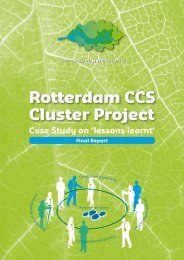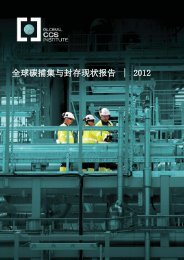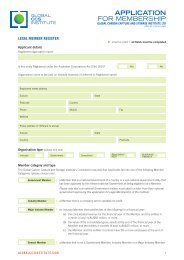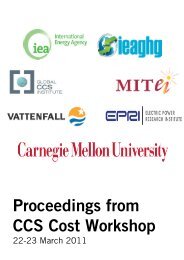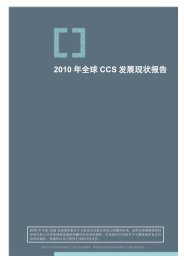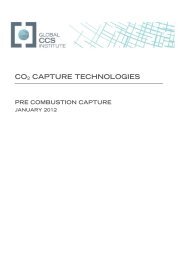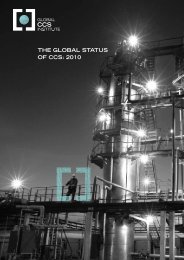Perceptions of CO2 Report - Global CCS Institute
Perceptions of CO2 Report - Global CCS Institute
Perceptions of CO2 Report - Global CCS Institute
- No tags were found...
Create successful ePaper yourself
Turn your PDF publications into a flip-book with our unique Google optimized e-Paper software.
Table 4: Factors influencing first impression <strong>of</strong> <strong>CCS</strong>Seeing <strong>CCS</strong> as …A positivetechnologyClean Useful Safe MatureAcceptance <strong>of</strong> risksrelated to newtechnologiesPositiveinfluence beta0.07Positiveinfluence beta0.09Positiveinfluence beta0.08Positive influencebeta 0.07Understanding thatCO 2 influences climatePositiveinfluence beta0.09Believing that CO 2affects health as sootdoesKnowing that CO 2 isemitted from powerplantsPositiveinfluence beta0.8Positive influencebeta 0.08Positive influencebeta -0.07Understanding thathuman body producesCO 2Positive influenceNegative influenceNegativeinfluence beta0.6Negativeinfluence beta -0.11Moving beyond these knowledge factors to consider how CO 2 impressions influenced <strong>CCS</strong>impressions, the only significant influence was exerted by the impression <strong>of</strong> CO 2 as “useful” (beta0.04, p < 0.05). Looking at the singular impression items, perceiving CO 2 as useful maderespondents perceive <strong>CCS</strong> as more useful as well, just as perceiving CO 2 as more dangerousmakes respondents perceive <strong>CCS</strong> as more dangerous. This tendency was repeated in the case <strong>of</strong>“CO 2 Clean”and “<strong>CCS</strong>Clean”, but the effect was relatively weak (beta 0.05, p < 0.05).Self-rated knowledge and <strong>CCS</strong> impressionWhen respondents’ self-rated knowledge was compared to their <strong>CCS</strong> impressions, higherawareness <strong>of</strong> <strong>CCS</strong> was generally linked to a lower percentage <strong>of</strong> “3: Neither/ Both equally”responses and a higher percentage <strong>of</strong> anchoring option responses (1 or 5). This implied thatrespondents with higher awareness and self-reported knowledge had more pronounced opinions.This was notably true for the “Safe” measure.Respondents who rated themselves as knowing a little about <strong>CCS</strong> (i.e., those who selected “3: Ihave heard about it and I know a little about it” options in the awareness <strong>of</strong> <strong>CCS</strong> questions, 20.1%<strong>of</strong> the total), also tended to be favorable towards <strong>CCS</strong>. This ‘little knowledge’ group account for thehighest percentages in “Positive” and “Useful” impression responses, and the second highestpercentages <strong>of</strong> “4” and “5” answer options chosen in the other impressions. Among respondentswho had “only heard about <strong>CCS</strong>” (i.e. who selected “2: I have heard about it but I don’t really knowwhat it is” options in the awareness <strong>of</strong> <strong>CCS</strong> questions – 24.5% <strong>of</strong> the total), only a few <strong>of</strong> themindicated their impression <strong>of</strong> <strong>CCS</strong> to be “Negative”, “Dirty”, “Useless”, and “Developingtechnology”. Almost a third, however, indicated to perceive <strong>CCS</strong> as at least somewhat dangerous.Among respondents who had never heard about <strong>CCS</strong> (i.e. who selected “1: No, I have not heardabout it” options in the awareness <strong>of</strong> <strong>CCS</strong> questions, 53.2% <strong>of</strong> the total), many selected “3:Neither/ Both equally” in relation to the impression options.Understanding how individuals perceive carbon dioxide | 31




